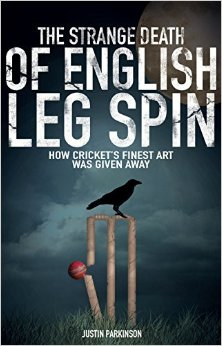The Strange Death of English Leg Spin
Martin Chandler |Published: 2015
Pages: 223
Author: Parkinson, Justin
Publisher: Pitch Publishing
Rating: 4 stars

My brother is a talented musician. In his youth he was in a band, in fact several bands. Some of these loose collections of, on the face of things at least, similarly minded souls were quite good, but none of them lasted very long. He always blamed the drummers for the lack of longevity. He told me they were almost always insane, and those who managed to stay on the right side of sanity were too temperamental to be relied on. I always thought that was a bit rich coming from him. His cricketing talents in no way matched his ability to fashion a decent tune out of just about anything, but when he did play he bowled decidedly iffy leg spin – in short, to use his own yardstick, he was one of cricket’s drummers.
There has never been a time in my life when England have had a top class leg spinner to call upon. If I try hard enough I can remember Robin Hobbs playing against Pakistan in 1971. With Intikhab Alam and Mushtaq Mohammad in the opposition ranks I never dreamt then it would be more than twenty years before I saw the like of Hobbs again, and sadly none of Ian Salisbury, Chris Schofield or Scott Borthwick have ever looked like establishing themselves at the highest level. That said it is worth remembering that despite the English game having produced a few good leggies in the past, we never have seen a great one.
There have of course been some truly great wrist spinners from Australia and the sub-continent, but as Justin Parkinson’s book explains the art was originally the invention of an Englishman, Allan Steel, a Lancastrian lawyer, not that either of those two factors are particularly relevant. Although perhaps his public school education was. Another man from such an establishment, in his case the famous playing fields of Eton, was Bernard Bosanquet. He developed the googly at the turn of the twentieth century, and lo and behold England had given the world the most mesmerising of cricketing skills.
Much of The Strange Death of English Leg Spin, as it must be, is taken up with the story of how wrist spin developed here and took hold of the English game to the extent that between the wars, Yorkshire apart, every county had one quality exponent, and some more than one. There is a particularly perceptive and well written passage on the subject of Ian Peebles, who might have become Bradman’s nemesis, but sadly lost his way.
Despite the historical context of Parkinson’s book there is much here that is new. He has spoken to Hobbs, and to his contemporaries Bob Barber and Warwick Tidy. He interviewed the first of the new wave of the late 1980s, although it was more of a ripple really, Andy Clarke of Sussex. Clarke’s successors, Ian Salisbury and Chris Schofield have also been spoken to at some length. Their stories are all similar – plenty of hope, but not always as much encouragement or support as was needed, and ultimately a liberal sprinkling of disappointment and frustration.
Parkinson goes on to bring the story up to date, looking at the attempts that have been made to turn Adil Rashid and Scott Borthwick into the northern hemisphere’s Shane Warne, including employing the services of Warne’s mentor, the late Terry Jenner. Of course to date none of the efforts made have really worked, although we hope that perhaps this summer’s Ashes will be the setting for Rashid to finally make the breakthrough and record a five-fer, something that hasn’t been done by an English leg spinner since the days of Doug Wright just after the last world war.
In his final chapter Parkinson puts forward his own six point plan for restoring English leg spin to the relative glories it enjoyed in the 1920s and 1930s. There are some interesting ideas, although I believe the only real solution to the problem had been identified in the first few chapters. The death knell for leg spin on our soft pitches was sounded with the change in the lbw law back in 1935, and short of repealing that alteration, or alternatively extending the law to allow the ball pitched outside leg to get a decision, the status quo will prevail. But of Parkinson’s ideas I do like the thought of young cricketers being obliged to take part in games of twisti twosti, and if you are not familiar with that concept I can only suggest you go out and buy Justin Parkinson’s admirable case study.






Oi, iffy chinamen if you don’t mind – if they’d gone from leg to off I’d have stood a chance!
Comment by David Chandler | 8:03pm BST 8 July 2015